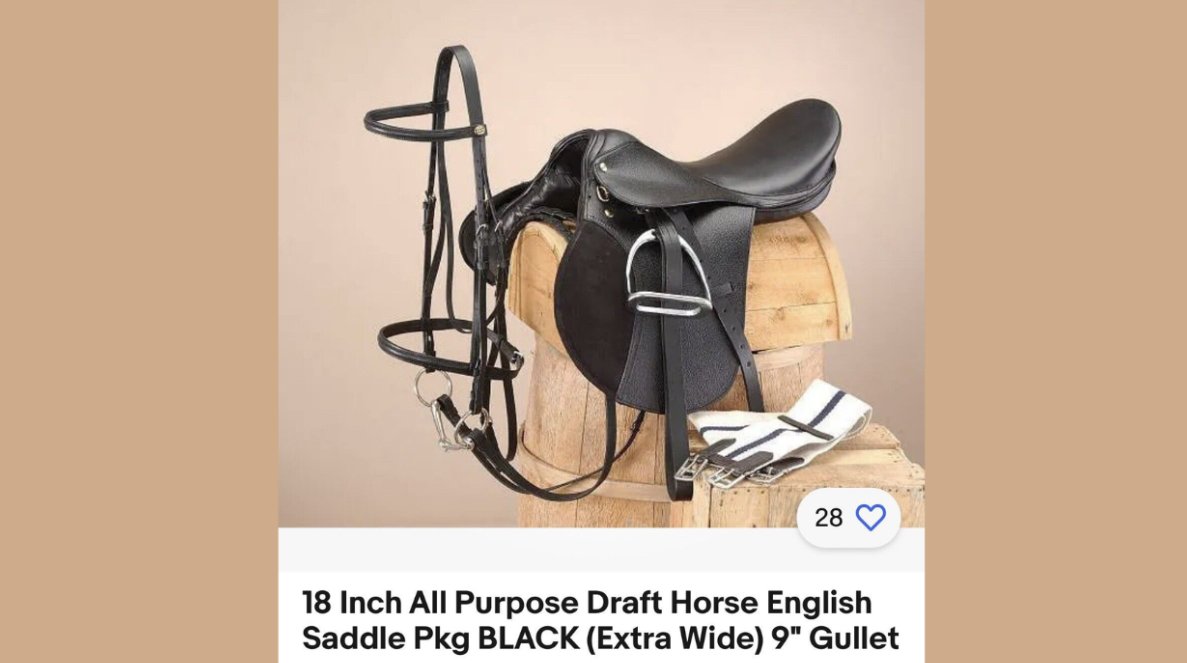English horse saddle

English horse saddles are specifically crafted for English riding styles, which focus on elegance, precision, and a close connection between horse and rider. They are designed to support various disciplines such as dressage, jumping, and showing, and each type is tailored to specific activities. Choosing the right saddle not only improves your performance but ensures comfort and well-being for both you and your horse.
The design of English saddles can be traced back to early European cavalry models. Over time, as riding evolved into sport and leisure, English saddles became more specialised. During the 18th and 19th centuries, saddles developed into the lighter, more refined versions we see today, built for balance, control, and close contact with the horse. Modern English saddles continue to reflect centuries of tradition while incorporating new materials and technology.
English saddles come in a variety of designs, each suited to different types of riding disciplines. Let’s look at the most common ones:
Dressage saddles are designed for the specific needs of dressage riders. They have a deep seat, allowing for a close and balanced position that encourages precision in the rider’s leg and seat aids. The long, straight flaps support the rider’s leg in a vertical position.
Jumping saddles are crafted with a flatter seat and forward-cut flaps to accommodate the shorter stirrup length used by jumping riders. These saddles allow for a more forward seat, necessary for navigating jumps, while offering support and grip during take-off and landing.
Also known as all-purpose saddles, these are designed for riders who engage in multiple disciplines, including jumping and flatwork. They are a versatile choice for beginners or casual riders, offering a middle-ground between dressage and jumping saddles.
Endurance saddles are lightweight and designed for long-distance riding. They prioritise comfort for both horse and rider over extended periods. These saddles typically feature extra padding and support in the seat.
Showing saddles are sleek and minimalist in design, built for flat classes where the rider’s seat and position are critical. These saddles offer little in the way of knee rolls or thigh blocks, as their primary goal is to allow the rider to present a neat, unobtrusive seat.
Each component of an English saddle plays a crucial role in its function and the comfort of both horse and rider.
The tree forms the foundation of the saddle, providing structure and support. It’s typically made from wood or synthetic materials like fibreglass or carbon fibre.
The seat is where the rider sits. In dressage saddles, the seat is deeper, while in jumping saddles, it is flatter to accommodate a more forward position.
c. Knee Rolls and Thigh Blocks
These padded sections provide support for the rider’s legs, helping maintain a stable position. Jumping saddles often have more pronounced knee rolls, while dressage saddles may feature larger thigh blocks.
The girth straps and billets secure the saddle to the horse, preventing it from slipping. They need to be strong and durable to withstand the tension of the girth.
The panels sit on either side of the saddle tree, distributing the rider’s weight evenly across the horse’s back to avoid pressure points and discomfort.
5. How to Choose the Right English Saddle
The saddle should fit the rider’s body type, providing adequate support and comfort. The size of the seat is essential – too large or too small, and the rider will struggle to maintain a balanced position.
Just as important is the saddle’s fit for the horse. A poorly fitting saddle can cause discomfort, pressure points, and even injury. It’s crucial to ensure the saddle fits well over the horse’s withers, back, and shoulders.
c. Riding Discipline Considerations
Your riding discipline will largely dictate the type of saddle you need. Dressage riders require a different design than jumping riders, and multi-discipline riders may benefit from an all-purpose saddle.
Leather saddles are heavier and require more maintenance, but they offer durability and a traditional aesthetic. Synthetic saddles, on the other hand, are lighter and easier to clean, making them popular with casual riders and beginners.
6. Leather vs Synthetic English Saddles
Leather saddles are the traditional choice, valued for their durability and classic appearance. However, they require regular cleaning and conditioning to prevent cracking and wear. Synthetic saddles are a modern alternative, offering a lightweight and low-maintenance option. While they may not last as long as leather, they are more affordable and easier to care for.
7. How to Measure Your Horse for an English Saddle
Measuring your horse correctly ensures the saddle fits well and avoids any discomfort. Start by measuring the horse’s withers and back length, and check that the saddle sits level without pinching the horse’s withers. A properly fitted saddle will not move or slide when riding.
8. Caring for Your English Saddle
Proper maintenance is key to keeping your saddle in good condition. Leather saddles should be wiped down after each ride and conditioned regularly to prevent drying and cracking. Synthetic saddles can be cleaned with soap and water. Always store your saddle in a cool, dry place to prevent damage.
9. Common Mistakes When Buying a Saddle
One of the most common mistakes is buying a saddle based solely on price or looks. A saddle that fits poorly can lead to discomfort or even injury for both the horse and rider. It’s essential to test the saddle on your horse and ensure it fits both you and your horse correctly.
10. English Saddle Accessories
Saddle pads provide additional cushioning and help to protect the horse’s back from pressure. They come in various materials such as fleece, foam, and gel.
The girth is used to secure the saddle in place around the horse’s belly. It should fit snugly but not too tight to avoid pinching.
Stirrups and leathers help riders maintain balance. They should be adjustable to fit the rider’s leg length and sturdy enough to handle the demands of the discipline.
Choosing the right English horse saddle is essential for both rider and horse comfort. Whether you’re a dressage enthusiast, a show jumper, or someone who enjoys casual rides, having the right saddle can make all the difference in performance and enjoyment. By understanding the different types of saddles, ensuring a proper fit, and maintaining your saddle correctly, you can ensure that both you and your horse have a comfortable and enjoyable riding experience.
FAQs About English Horse Saddles
1. What is the best type of saddle for beginner riders?
A general-purpose saddle is ideal for beginners as it offers versatility and comfort for multiple riding disciplines.
2. How often should I clean my saddle?
Leather saddles should be cleaned and conditioned after every few rides, while synthetic saddles can be cleaned less frequently, depending on usage.
3. Can I use a dressage saddle for jumping?
Dressage saddles are not designed for jumping. It’s best to use a saddle designed specifically for the discipline, such as a jumping saddle.
4. How do I know if a saddle fits my horse properly?
A well-fitted saddle sits level on the horse’s back, doesn’t pinch the withers, and allows for free shoulder movement.
5. Should I buy a leather or synthetic saddle?
Leather saddles are more durable and traditional, while synthetic saddles are lightweight and easier to maintain. Your choice depends on your budget, preference, and riding style.






